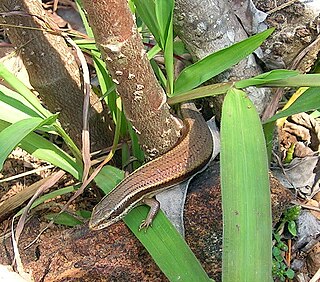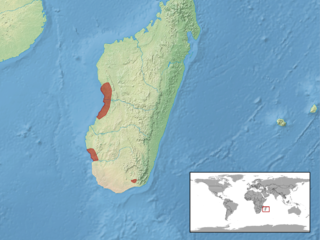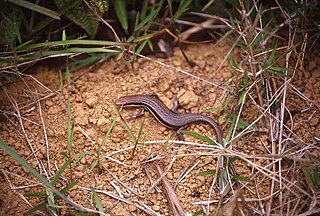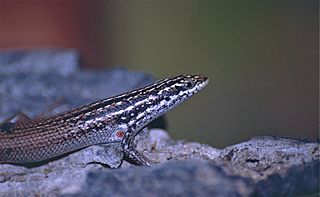
Riopa punctata, also known as the common dotted garden skink, common snake skink, punctate supple skink, or spotted supple skink is a species of skink found in Bangladesh, India, Nepal, Pakistan, Vietnam and Sri Lanka.

Trachylepis is a skink genus in the subfamily Lygosominae found mainly in Africa. Its members were formerly included in the "wastebin taxon" Mabuya, and for some time in Euprepis. As defined today, Trachylepis contains the clade of Afro-Malagasy mabuyas. The genus also contains a species from the Brazilian island of Fernando de Noronha, T. atlantica, and may occur in mainland South America with Trachylepis tschudii and Trachylepis maculata, both poorly known and enigmatic. The ancestors of T. atlantica are believed to have rafted across the Atlantic from Africa during the last 9 million years.

Lygosominae is the largest subfamily of skinks in the family Scincidae. The subfamily can be divided into a number of genus groups. If the rarely used taxonomic rank of infrafamily is employed, the genus groups would be designated as such, but such a move would require a formal description according to the ICZN standards.

The Noronha skink is a species of skink from the island of Fernando de Noronha off northeastern Brazil. It is covered with dark and light spots on the upperparts and is usually about 7 to 10 cm in length. The tail is long and muscular, but breaks off easily. Very common throughout Fernando de Noronha, it is an opportunistic feeder, eating both insects and plant material, including nectar from the Erythrina velutina tree, as well as other material ranging from cookie crumbs to eggs of its own species. Introduced predators such as feral cats prey on it and several parasitic worms infect it.

Trachylepis maculata, the spotted mabuya, is a species of skink in the genus Trachylepis recorded from Demerara in Guyana, northern South America. It is placed in the genus Trachylepis, which is otherwise mostly restricted to Africa, and its type locality may be in error. It is an unstriped, olive-brown, grayish animal, with dark spots all over the body. Its taxonomic history is complex due to confusion with Trachylepis atlantica from the Atlantic Ocean island of Fernando de Noronha and doubts regarding its type locality.
Under the International Code of Zoological Nomenclature (Code), the name-bearing type is the biological type that determines the application of a name. Each animal taxon regulated by the Code at least potentially has a name-bearing type. The name-bearing type can be either a type genus, type species, or one or more type specimens. For example, the name Mabuya maculata has often been used for the Noronha skink, but because the name-bearing type of the former, a lizard preserved in the Muséum national d'histoire naturelle in Paris, does not represent the same species as the Noronha skink, the name maculata cannot be used for the latter.
Trachylepis tschudii is an enigmatic skink, purportedly from Peru. First described in 1845 on the basis of a single specimen, it may be the same as the Noronha skink (T. atlantica) from Fernando de Noronha, off northeastern Brazil. T. tschudii represents one of two doubtful records of the otherwise African genus Trachylepis on mainland South America; the other is T. maculata from Guyana.
Trachylepis ferrarai, also known commonly as Ferrara's mabuya, is a species of skink, a lizard in the family Scincidae. The species is endemic to Somalia.
Trachylepis rodenburgi, also known commonly as Rodenburg's mabuya, is a species of skink, a lizard in the family Scincidae. The species is endemic to West Africa.

Trachylepis boettgeri, commonly known as Boettger's mabuya, is a species of skink, a lizard in the family Scincidae. The species is endemic to Madagascar.

Benson's mabuya is a species of skink, a lizard in the family Scincidae. The species is native to Western Africa.

Trachylepis bocagii, also known commonly as Bocage's skink, is a species of lizard in the family Scincidae. The species is native to southern Africa.
Trachylepis boulengeri, also known commonly as Boulenger's mabuya, is a species of skink, a lizard in the family Scincidae. The species is indigenous to southeastern Africa.

Trachylepis dumasi is a species of skink, a lizard in the family Scincidae. The species is endemic to Madagascar.

Trachylepis gravenhorstii, also known commonly as Gravenhorst's mabuya, is a species of skink, a lizard in the family Scincidae. The species is endemic to Madagascar.
Trachylepis hemmingi, also known commonly as the Somali mabuya, is a species of skink, a lizard in the family Scincidae. The species is endemic to Somalia.
Trachylepis hoeschi, also known commonly as Hoesch's mabuya and Hoesch's skink, is a species of lizard in the family Scincidae. The species is native to southwestern Africa.

Trachylepis nancycoutuae, also known commonly as Nancy Coutu's mabuya and Nancy Coutu's skink, is a species of lizard in the family Scincidae. The species is endemic to Madagascar.
Trachylepis wingati, also known commonly as Wingate's skink, is a species of lizard in the family Scincidae. The species is indigenous to northeastern Africa.










